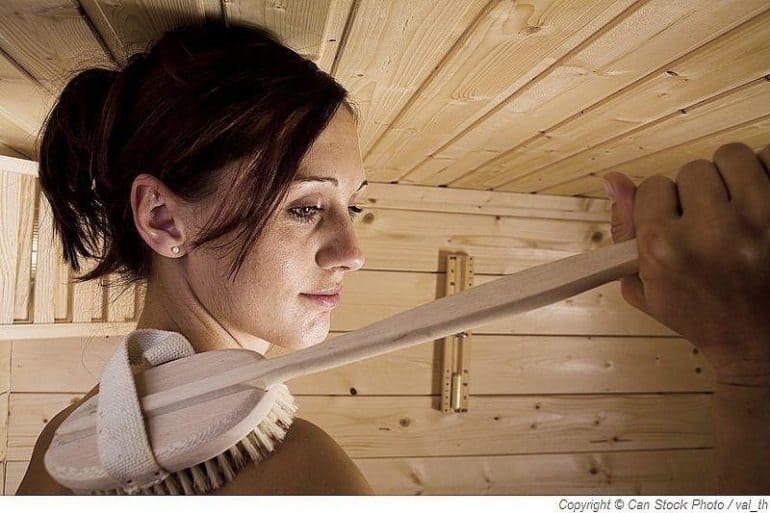Sweating in the sauna
The so-called sauning takes place in the sauna. The sauna is a room, mostly made of wood, which is heated with the help of a sauna stove. The temperature in it is between 176 °F and 212 °F, in rare cases up to 230 °F. Nowadays, electric stoves are mostly installed instead of oil and wood stoves. These are usually simpler and easier to operate. The two to three tiered benches are arranged in such a way that the temperature increases more and more towards the top.
Very important in the sauna is the air circulation. Fresh air is continuously supplied to the sauna, which is immediately heated by the sauna heater, thus enabling the constant temperature in the room. In order to increase the perceived temperature in the sauna and thus the humidity, water is poured on hot stones positioned on the sauna heater. This is the so-called infusion, the water vapor produced in the sauna. Often, various essential oils are added to the infusions.
Source of beauty and well-being
Taking a sauna stands for beauty. It significantly improves the appearance of the skin, even acne, because the skin is cleansed by sweating. Your skin is strongly supplied with blood through the sauna and thus it is supplied with plenty of nutrients and oxygen. In the sauna heat, the metabolism of the skin works twice as fast as in normal conditions. The wonderful effect: a firm, rosy skin on the whole body! The pores of the skin are opened by the heat, so that products for care can be absorbed in the rest breaks and after the sauna visit to a special extent.
Skin texture is improved
If one looks at the long-term and lasting facts, then it is to be stated that very many sauna visitors, who sauna regularly, have a substantially stronger acid protection coat. As a result, significantly fewer minerals are lost through the skin when sweating. It is not harmful to sauna with dry or even wet hair. If you want to do something good for your hair, you can apply a hair treatment while taking a sauna, which can be absorbed particularly well by the heat.
But that’s not all!
The sauna is a source of well-being. Regular visits to the sauna have a positive effect on the autonomic nervous system and also on general well-being. The circulation gets going. Numerous toxins, which have accumulated in the body, are removed by sweating. The body is purified and cleansed. In addition, the metabolism is stimulated and also the condition is improved. It strengthens the immune system and prevents, for example, colds. In the long run, the body learns better and better how to adapt to the alternation of heat and cold and develops a better and faster reaction to it. Stressed and time-pressured minds find peace here, the body relaxes and unwinds.
Health benefits
Sauna is relaxation for body, skin and soul. Sauna exercises the cardiovascular system, the skin and muscles get better blood circulation. It is quite undisputed that sauna bathing has an extremely positive effect on mood and thus promotes relaxation. For people suffering from sleep disorders and headaches, the sauna is a clear recommendation. Sauna infusions with appropriately matching fragrances of essential oils can specifically improve these disturbing deficits. Sauna visitors who follow the golden rules of correct sauna bathing will optimally promote relaxation and health.
Golden sauna rules
- Enter the sauna as calmly as possible.
- Shower before the first sauna session and remove make-up if necessary.
- Dry off thoroughly, as dry skin sweats more quickly than moist skin.
- Stay in the heat for about 8–10 minutes during the first sauna session.
- As the level or bench rises, so does the temperature (short, heavy sweats on the upper benches are most effective and healthy).
- Listening to your body and feeling comfortable, sit on the lowest bench level for the last 1–2 minutes so that your circulation can get used to the upright position again.
- After the sauna, the cooling down phase takes place. To protect the circulation and to prepare the heart gently for the cold, a cold shower is applied, starting at the right ankle and moving down the arms and legs towards the heart. Warm and even lukewarm water is taboo, because otherwise the relaxing feeling is lost afterward. Very brave sauna visitors can dare to jump into the plunge pool.
- Now comes the resting phase (after each sauna session) to relax the body. The length of this phase should be the same as the sauna session itself. Very important: the body must not cool down during this time. To prevent this, a blanket or bathrobe can be used.
After the end of the resting phase, the process starts again from the beginning: sweating, cooling down phase, resting phase. The 2nd and 3rd sauna session can now be extended to up to 15 minutes. Basically, however, listen to your body and determine the duration of the sauna session, the height of the bench and your preferred sitting position yourself.
The right accessories
- Large bath towel as a base
- A towel for drying off
- Bathrobe, slippers
- Shower-bath, hair shampoo, body lotion or skin care products
Who should avoid the sauna?
A sauna visit is unsuitable for people suffering from high blood pressure, fever, epilepsy, inflammation, colds, skin and lung diseases and heart problems. If unsure, consult your doctor before taking your first sauna. If you suffer from low blood pressure, it is better to lie down instead of sitting when taking a sauna, as well as not to leave your legs in a hanging position while doing so.
As you can see, sweating is not “hot air” at all – but rather a source of beauty and health.

